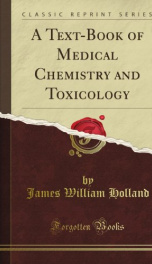a text book of medical chemistry and toxicology

Matter is anything that has weight, or anything that has length, breadth, and thickness; in other words, anything that occupies space and is perceptible to the senses. Matter is never absolutely at rest. If not the body in its mass, at least its particles are in incessant agitation.Energy or force is that which gives matter its properties. Matter is thus resolved into a " mode of motion." Energy comes from work and can be changed to work. Such material changes as are caused by the energy of heat, light, electricity, magnetism, and mechanical motion are said to be physical, while others are called chemical. For the sake of simplicity those changes called physical are dealt with in that branch of science known as physics, but as some of them arc very closely related to chemical changes, a thorough study of the latter necessarily involves some knowledge of the physical changes.The universal ether is the thin elastic medium pervading matter and space and through which radiant energy Table of Contents Introduction 17; Matter and Force 17; Metrology 17; Heat 28; Thermometry 28; Specific Heat 34; Melting and Freezing 35; Evaporation 39; Boiling 41; Magnetism and Electricity 45; The Galvanic Current 45; The Induction Coil 5 2; Cathode and Rontgen Rays 53; Light 55; Spectroscopy 55; Polarimetry 5 8; The Chemical Elements- 62; The Non-metals 65; Oxygen 65; Ozone or Allotropic Oxygen 74; Hydrogen 77; Water 83; Hydrogen Dioxid 86; Solution-Diffusion-Dialysis-Osmosis 89; Solution 89; Diffusion 92; Dialysis 93; Osmosis 94; Nitrogen and the Argon Group 97; Nitrogen 97; Carbon and its Oxids 98; Carbon 98; Carbon Monoxid 100; Carbon Dioxid *°2; Chemical Philosophy 108; Atomic Theory i°9; Chlorin 118; Adds, Bases and Salts' I23; Dissociation I27; The Chemical Elements {Continued); The Non-metals {Continued)-Hydrochloric Acid 135; Compounds of Chlorin Containing Oxygen 139; Other Halogens r42; Bromin J42; I
Info about the book
Author:
Series:
Unknown
ISBN:
0071700552
Rating:
3.5/5 (4)Your rating:
0/5
Languge:
English
Users who have this book
Users who want this book
What readers are saying
What do you think? Write your own comment on this book!
write a commentif you like a text book of medical chemistry and toxicology try:
Do you want to exchange books? It’s EASY!
Get registered and find other users who want to give their favourite books to good hands!


